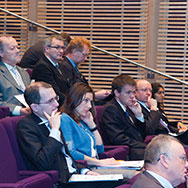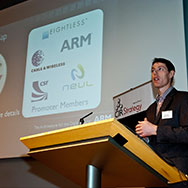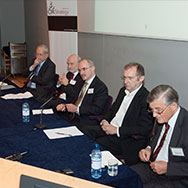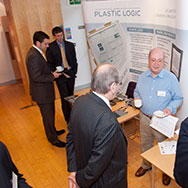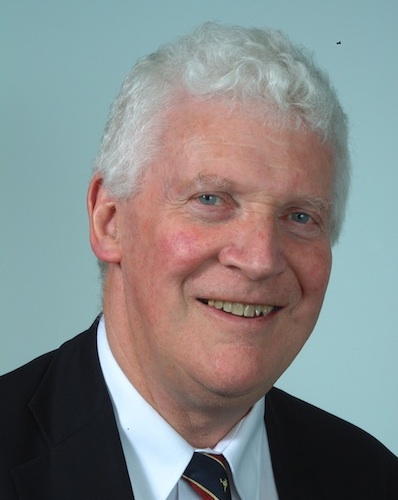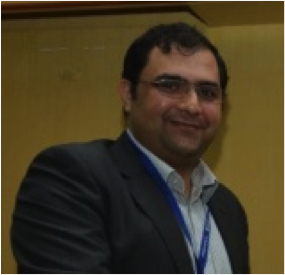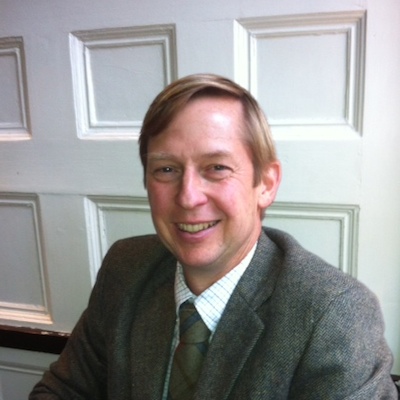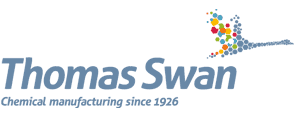Coming Up
HVM Graphene+ 2014
-
Oxford, UK - Thursday, 15 May 2014
Conference Summary PDF
Speakers HVM Graphene+ 2014 Oxford
-
Session 1
-
Dr Justin Hayward MBA MMath, Director,
Cambridge Investment Research
Introduction Justin is the founder director of CIR. He specialises in delivering business intelligence, assembling high-level project business strategy teams, building value networks and structuring conferences and their focus marketing. He is a theoretical physicist by training, taking advanced degrees MMath, and PhD from Cambridge University. He was the PhD student of Professor Stephen Hawking beginning in 1991. After a 6-month postdoc in Paris, he was with Deutsche Bank London from 1996-2000 as a relative value analyst, and took an MBA from Cambridge Judge Business School in 2000/1.
-
Professor Pete Dobson OBE, F Inst P, Principal
Warwick Manufacturing Group & Queen’s, Oxford
Chairman’s Introductory Remarks
Synopsis: The outputs of research on graphene and other carbon-based functional materials continue to feature in science literature. There is an keenness amongst politicians and some investors to see financial returns from this in the near future. This gathering of experts might point to just how valuable various nanomaterials based on carbon may become, with theory, case studies, pricing strategy and business models in real mature industries that may be disrupted by the new production. The conference will also debate innovation services to these sectors by government agencies from a UK, an EU, and a global market perspective.
Professor Peter Dobson was recently retired by Oxford University and is now a Principal Fellow at Warwick Manufacturing Group and has associations with several other Universities to assist with Innovation. He recently completed his duties as the Nanotechnology Advisor to RCUK. He has created several companies and undertakes consultancy projects over a wide range of topics in nanotechnology, biosensing, optoelectronics and materials science. -
Professor Vladimir Falko FInstP
Lancaster University
Vladimir Falko is a Disintiguished Professor of physics whose research Interests include graphene and related two-dimensional atomic atomic crystals: electronic transport and optical properties; structures of two-dimensional atomic materials; states of two-dimensional materials, the fundamentals of nanoelectronics, spintronics, and nano-electro-mechanical systems; quantum optics and optical properties of semiconductor quantum dots.
Vladimir has been invited to discuss briefly the theory and practical applications of graphene and other carbon-based functional materials that might be discussed in the conference. -
Dr Felice Torrisi & J Patrick Frantz
Cambridge Graphene Platform
Dr Felice Torrisi is a Research Fellow at Cambridge Graphene Centre and Darwin College. He is in the Nanomaterials and Spectroscopy Group in the Electrical Engineering Division
J. Patrick Frantz received BA (1995) and MEE (1997) degrees from Rice University and returned to Rice in 1999 to serve as the Executive & Technical Director for the Center for Multimedia Communications. In 2006 he was awarded the Outstanding Young Engineering Alumnus award for his efforts in international engineering education. Shortly thereafter, Patrick moved to Japan, working in the semiconductor and display industries (Xilinx, Barco and UniPixel Displays) and receiving an MBA from Temple University Japan in 2011. Patrick then established Graphene Platform Inc. in the US.
Synopsis: This short talk from Felice and Patrick will focus further on the range of possible applications of graphene and some of the technology challenges that the potential new industry faces. It will be of general interest to anyone moving into the field of graphene, particularly those CTOs and technology consultants and strategists briefed to look into graphene opportunities.
-
Session 2
-
Dr Martin Kemp
Haydale
The Role of Functionalisation in the Graphene Supply Chain
Following a career in materials science research at DERA during which he was awarded the Donald Julius Groen prize from ImechE, Martin Kemp moved into corporate marketing for QinetiQ, including a secondment to the European Commission, before spending five years with DTI Global Watch Service developing international technology transfer in the high performance engineering sector responsible for Western Europe. As a Chartered Marketer, he has 12 years experience in technology transfer including commercial exploitation of IP. Martin now speaks as business development director at Haydale. -
Dr Richard van Rijn, CTO
Applied Nanolayers
Wafer scale production of graphene: opportunities and challenges
Synopsis: Wafer scale production of graphene by CVD methods promises to be a scalable and affordable way of producing graphene with large domain size and high electron mobility. I will highlight several challenges in growth, transfer, and characterization of the graphene that need to be addressed to get to a reliable graphene supply.
Biography: Richard van Rijn received his PhD degree in physics from Leiden University working on the development of a reactor system for studies of surface catalysis using x-ray diffraction at the European Synchrotron Radiation Facility. Currently he is co-founder of Applied Nanolayers, a startup company developing wafer scale graphene production. -
Dr Paul Reip, Founder
Intrinsiq Materials
Electronic inks and pastes for packaging, batteries, sensors, displays and touchscreens
Dr. Paul Reip serves as the Director of Government and Strategic Programmes at Intrinsiq Materials Ltd. and Intrinsiq Materials, Inc. Dr. Reip joined the UK MOD in 1982. He spent the early part of his career as research scientist in weapon programmes, where he was heavily involved in International Collaboration with the USA, Europe and NATO. He served as Department Manager of Electro Optic Warfare since 1995 and in 1998, moved to lead the Guns and Warheads Department. He founded QinetiQ Nanomaterials Ltd., and served as the Chief Executive Officer since 2002 and as Chief Technology Officer since 2005. Dr. Reip serves as Director of Nanotechnology Ventures in QinetiQ PLC and represents both companies in various National and International nanotechnology forums. He is a Board Member of the UK Nanotechnologies Industries Association. Dr. Reip holds a PhD in Materials from Brunel University. -
Toby Middlemiss
Product Manager Motorsport & Composites,Oerlikon
Diamond coatings transforming surface engineering
Synopsis: Growth in diamond-like carbon and DLC coatings currently available in the market place. Applications where diamond coatings have changed the industry facilitating technology to move forward. Biography: Toby Middlemiss, Product Manager Components joined Oerlikon Balzers in 2008 following a two-year joint research and development collaboration between the Oerlikon and Cranfield University, where he put his Engineering degree and Masters in Motorsport engineering and management to full use developing new coatings. -
John Bexkens
Product & Key Account ManagerOerlikon
Diamond coatings transforming surface engineering
Biography: John Bexkens joined Oerlikon Balzers Luxemburg in 2007 as Product Manager & Key Account Manager for the CVD Diamond coatings. He has since more than 35 years’ experience in production of cutting tools. He is responsible for all applications where CVD Diamond can help to an better and optimize production flow. -
Professor Tony Anson
Brunel University
Adding Value to Medical Implants by the use of Diamond-Like Carbon Coating
Diamond-Like Carbon (DLC) describes a thin-film of diamond and graphite that can be desposited onto metals, polymers and ceramics using plasma. The technique, in this case is referred to as plasma enhanced chemical vapour deposition. The applications for DLC is widespread, ranging from engineering cutting tools, medical implants, electrical insulation, low-friction, abrasion resistant surfaces and aesthetic coatings. Some of these applications will be described and how commercial advantage is being exploited.
Tony Anson trained as a mechanical engineer and had the benefit of experiencing many diverse opportunities in broad engineering disciplines that necessitated a long and willing relationship with materials science, biology and physics. The need for this multidiscipline behaviour is evidenced in the successful generation of medical implants, plasma deposited thin-film coatings, manufacturing processes: all of these leading to a commercial transition from the academic environment. -
Gavin Farmer
Carbodeon Ltd Oy
NanoDiamond materials: Hard as Hell, but Cooler
Carbodeon manufactures a portfolio of materials based on NanoDiamond technology. These serve multiple applications in diverse industries by leveraging the extreme thermal and physical properties of diamond and nanoscale effects. Gavin’s presentation will focus on wear and friction improving applications in plating and coatings.
Gavin has a background in automotive powertrain systems, in which he has held manufacturing, engineering and business roles in both a large corporation and small high tech companies. Gavin has a degree in Manufacturing Engineering from the University of Cambridge, where he also holds the post of Industrial Fellow.
-
Ian Burnett, Director
JEMI UK
Following an education in Electrical Engineering and then Mechanical and Production Engineering at Loughborough and Leicester University, Ian became a practised team player and proven leader in the fast moving semiconductor equipment industry. In his 20 + years of experience, Ian has held Directorships in 7 Companies, four start-ups, one trade association, a business incubator and one a rescue. Three Companies have been sold via trade sales and remain active under new ownership. Ian has been active in setting up subsidiary companies in European and Asian Countries, and has experience as part of a core team, in raising finance, preparation of business plans, joint ventures and Company disposals and has a broad general management experience typical in smaller businesses. Ian is a past member of the National Advisory Committee for Electrical and Electronic Devices and Materials and a past Chairman of the Scottish Microelectronics Centre, a business incubator located in Edinburgh. Since the sale of WED in 1997, Ian has been running his own business, IDB Technologies Ltd which sells equipment and materials used for semiconductor manufacture. The business has 3 employees and has approximately £1.5m of sales. Ian is a member of the Institution of Engineering and Technology, I Eng, MIET.
-
Session 3
-
Dr Ravi Sundaram, Development Scientist
Oxford Instruments plc
,Capital Equipment considerations for 2d materials moving from Lab-to-Fab
Development of 2-D materials and their applications is now centred on the academic sector, which needs reliable process tools for fabrication and also analysis methods. Equipment companies intending to follow 2-D materials towards high volume manufacturing must first partner with the research base, in readiness for pilot line and HVM phases.
Dr Ravi Sundaram is a Development Scientist at Oxford Instruments Nanotechnology tools. He has been involved in 2d materials research in several institutions such as EPFL, Switzerland, Max Planck Institute Stuttgart, Germany, IBM Watson Research Labs, NY. He was conferred a PhD in Physics in 2011 and moved to Cambridge university as a research fellow before joining Oxford Instruments in March 2014. -
Paul Ladislaus, Senior Chemical Engineer
Thomas Swan
A new industrially relevant route to high quality graphene
Synopsis: Thomas Swan Advanced Materials division is dedicated to the development of high value materials for emerging technologies. Through a collaboration with Trinity College Dublin we have identified a reliable route to high purity, non-oxidised graphene for applications in electronics, energy storage and composites. This process is currently being scaled to deliver kg/day graphene products at our UK manufacturing site. This presentation will describe the key steps in our process development and the high quality of the resulting graphene products.
Paul is a Chartered Chemical Engineer with extensive experience in Chemical Process Operations and Process Technology Development. He works for the Advanced Materials Division at Thomas Swan as Senior Chemical Engineer, focussing on the scale-up of new processes for carbon nanotube and graphene products. Paul holds a Master’s Degree in Chemical Engineering from the University of Cambridge and is a Member of the Institute of Chemical Engineers. -
Ian Walters, CTO,
Perpetuus Carbon Group
Graphene alternatives: are they underestimated?
Ian is a senior technologist and materials entrepreneur. -
Dr Emma Kendrick, Chief Technologist - Energy Storage
Sharp Laboratories of Europe Ltd
,The use of carbon in next generation battery technologies
Carbons can be used in many battery technologies as either a conductive additive in composite electrodes or as an active anode material. This talk will look at the use of different carbons in current and future battery technologies.
Biography: Dr Emma Kendrick is Chief Technologist in Energy Storage for SHARP Laboratories of Europe, She has over 15 years’ experience in energy materials R&D and joined SLE 4 years ago as an energy storage specialist. Previous to SHARP she was lead scientist for two battery start-up companies in Oxford. -
Del Stark, Founder
Nanopro
Biography: Since 2001, Del Stark has been analysing technologies and market trends to assist companies in understanding how nanotechnology could improve their products and processes allowing them to innovate, make new product claims, find a competitive edge and offer improved services to customers. In 2011 Del Stark Technology Solutions was launched to deliver bespoke technology analysis and scouting services to industry.
-
Session 4
-
Nabil Zahlan
Graphene SIG
Working together to commercialise Graphene applications
Biography: Nabil is focused on developing and supporting the innovation strategy for the UK chemistry-using industries. Currently this includes leading the establishment of the UK Graphene Special Interest Group. He has had a career at AkzoNobel in operations and leadership and has international degrees in Mechanical Engineering, applied mechanics and an MBA in innovation management. -
Dr Alec Reader, Nanotechnology Community
The KTN Ltd
The UK Nanomedicine Market: Current Status & Future Prospects Synopsis: A nanomedicine is defined as a material or device that uses nano-sized tools for the diagnosis, prevention and treatment of disease. The market for nanomedicine was valued at US$78.54 billion in 2012 and is expected to reach a value of US$177.60 billion in 2019. The key driver for this market expansion is the introduction of new technologies that are in development. In the UK, the key areas of focus are personalised medicine, regenerative medicine and synthetic biology – nanomedicine has clear synergies with each of these fields. The UK is well positioned to take full advantage of its fundamental science base, and with the necessary support and infrastructures in place, is likely to be an international leader in nanomedicine. In order to capitalize on this potential, more must be done to fuel the nanomedicine landscape. Nanomedicines, as their name suggests, are small entities but have huge potential impact, both financial in the UK but, more importantly, to global human health and well-being.
Biography: Dr Reader is currently heading the nanotechnology activities of KTN ltd. He has over 30 years experience in the micro and nano-electronics industries, working most recently at Innos and Polymer Vision. He is accredited with establishing Innos at the forefront of industrial R&D, championing the company's ability to bridge the gap between emergent technologies and commercial exploitation. He was instrumental in obtaining a very large order from, and subsequently selling Innos to, Polymer Vision of The Netherlands (a Philips spin-out company). His tenure at Innos (Polymer Vision) was a continuation of a successful career that includes prominent positions as International Marketing Manager and Business-Line Manager at Philips Analytical (Semiconductors) where he is widely acknowledged for growing the turnover of a new business to over €40m pa in three years. Prior to developing a business oriented career, Dr Reader was a Head of Department at ST-Microelectronics in France, a post–doctoral fellow at Delft Technical University and spent about 20 years at Philips Research and Philips Semiconductors in Eindhoven. Dr Reader has succeeded in transforming four academic start-up’s to mainstream companies and has actively led large (in excess of €150m) European projects in the semiconductor industry. He brings this knowledge to the NanoKTN along with a wealth of business development and program management expertise gained through involvement with European MEDEA (Eureka program), Irish-IDA and UK-DTI technology transfer programs in micro & nano-electronics, telecoms and ICT sectors. His achievements include over 140 published technical papers, along with many review articles and key patents. Dr Reader holds a PhD in Science of Materials (Solid State Physics) from the University of Birmingham (UK) and a B.Sc (Hons) in Physics. He is a Fellow of the Institute of Physics, and a member of the Institute of Directors, the Institute of Engineering & Technology, the IEEE, and the Institute of Materials. -
Dr Tom Taylor, Director of Future Businesses
CPI
Graphene applications and the CPI approach to Innovation
The talk will illustrate how CPI has applied its innovation model to Printable Electronic applications with case studies of successful product developments and will indicate how CPI will deliver the new Graphene applications centre.
Tom is a Senior Industrial Innovation Manager with 20 years experience of high technology product and business development. He has a materials technology background and his focus has been on integrating novel materials into industrial scale processes. He specialises in enabling clients to bring products to market quickly and cost effectively whilst managing risk through a thorough understanding of the specific needs of industry. Tom has collaborated intensively with the plastic electronics community, having been on the board of the Organic Electronics Association, the Printed Electronics Leadership Group and the Cambridge University IKC Industry Board. Tom works closely with government organisations such as BIS, TSB and ESP KTN in defining strategy for the commercialisation of innovation in printable electronics in the UK. In addition, he also helps clients to win venture capital funds, as well as funding for collaborative projects. He is always looking to bring new entrants into the printable electronics field.
Previously Tom was Head of the chemicals business at Frost & Sullivan and held senior market and operational rolls at ICI, where he was responsible for businesses in the UK, France and Thailand. He has a Chemistry DPhil from Oxford University. -
Dr Pēteris Zilgalvis, J.D.
European Commission Head of CNECT & Oxford University
Innovation doesn’t just fall from the sky: law and policy
Synopsis: Pēteris Zilgalvis addressed the role of the State in collaboration with private actors in the "Innovation Triangle" of regulatory, business and innovation policy. Tools such as research and innovation funding, public procurement of innovation, an "innovation-friendly policy stance" in addressing new technologies and the innovation principle in regulatory impact assessment will be discussed. The focus will be on sectors where, because of the predominant state role, there is a requirement for policymakers to think and act with innovation in mind (education, healthcare, transformation of government and to a lesser extent - climate change/energy security, and cybersecurity/defence) and on a sector where the regulatory framework can promote or block innovation, but where the creative leadership is private (FinTech).
Biography: Pēteris Zilgalvis is the EU Visiting Fellow and Associate of the Political Economy of Financial Markets Programme at St. Antony's College, University of Oxford for 2013-14. He is the Head of Unit for eHealth and Well Being in DG Communications Networks, Content and Technology (CNECT) in the European Commission. From 2005 until 2010, he was Head of the Governance and Ethics Unit, European Commission. From 1997 to 2005, he was Deputy Head of the Bioethics Department of the Council of Europe, in its Directorate General of Legal Affairs. In addition, he has held various positions in the Latvian civil service (Ministry of Foreign Affairs, Ministry of Environment). He was Senior Environmental Law Advisor to the World Bank/Russian Federation Environmental Management Project and was Regional Environmental Specialist for the Baltic Countries at the World Bank. P. Zilgalvis studied political science (cum laude) at the University of California, Los Angeles. At the Law Centre of the University of Southern California he obtained his JD (Doctor of Jurisprudence) and received the Darling Foundation academic scholarship. He completed the High Potentials Leadership Program at Harvard Business School. He is a member of the California State Bar. He has published over 30 publications on bioethics, economics, European and environmental law.
Venue
Saïd Business School, Oxford, England - state-of-art tiered auditorium, excellent, bright, relaxed, high level networking & exhibition spaces, meeting areas, great food, plentiful coffee & drinks.
